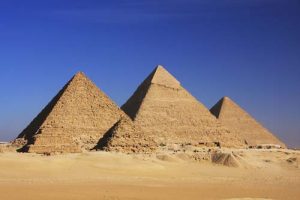Just because a mystery is 4500 years old doesn’t mean it can’t be solved…”
This could be the motto of the exceptional scientific mission launched October 25, 2015, under the authority of the Egyptian Ministry of Antiquities, initiated, designed and coordinated by the Faculty of Engineering of Cairo and the French HIP Institute (Heritage, Innovation and Preservation). Radiographic muons, aka cosmic particles, infrared thermography, photogrammetry, scanner and 3D reconstruction: the most innovative technologies will be used by researchers of international renown and three major universities: The Faculty of Engineering of Cairo University, Université Laval of Quebec and Nagoya University of Japan. Their goal: to probe the heart of the largest pyramids of Egypt, without drilling the slightest opening.
Fast forward a simple year, this unprecedented event has happened.
The ScanPyramids project continues to break new ground on the Great Pyramid of Giza whilst barely laying a finger on it. Their latest find shows that the 4,500-year-old monument has even more mysterious hidden cavities and corridors than their previous work showed.
Their first new discovery is a cavity about 105 meters (345 feet) up from the ground on the northeastern corner of the pyramid. This is followed by another “void” discovered on the north face of the structure, AFP reports.
Archaeologist Dr. Nicholas Reeves suggested in 2015 that the tomb of Queen Nefertiti could be behind the burial chamber of King Tutankhamun but others think different and believe the cavities are simply just part of the pyramid’s structure. Former Egyptian Minister of State for Antiquities Affairs and Director of the Giza Pyramids Excavation said: “The core of the pyramid was built using long stones and small stones. If you know that, you’ll find anomalies everywhere.”
Muons technology is extremely advanced. They are like the X-rays which can infiltrate the body and permit bone imaging, thus, scientists can use this technology to explore several meters of stone before being retained. The cavities discovered a short time ago are under study and many experts are completely sure there will be many surprises.
Increases in technology with X-ray and scanners will help archeologists and historians alike to unravel many of the mysteries that surround not only the Great Pyramids, but, also other structures that are not currently being excavated. Being able to ‘excavate’ by using newer technology will also preserve the magnitude of the ancient places around the world.
UKA, a leader in creating precision lenses, is here to not only custom design, but manufacture your lens for such specific types of equipment for infrared thermography, photogrammetry scanners to use with 3D reconstruction.
“In the longer term, given the archaeological wealth of Egypt, we imagine applying these techniques to other monuments, Hany Helal, (Professor of Rock mechanics at Faculty of Engineering, Cairo Uniiversity), concludes. Either to restore or to discover them. If these technologies are effective, they can even be implemented in other countries.”
Universe Kogaku designs and manufactures optical lenses for infrared thermography, photogrammetry scanners, security, high tech and electronic applications. We stock 1000’s of standard lens assemblies and can custom design a solution for scanners, CCTV, CCD/CMOS, medical imaging, surveillance systems, machine vision and night vision systems.